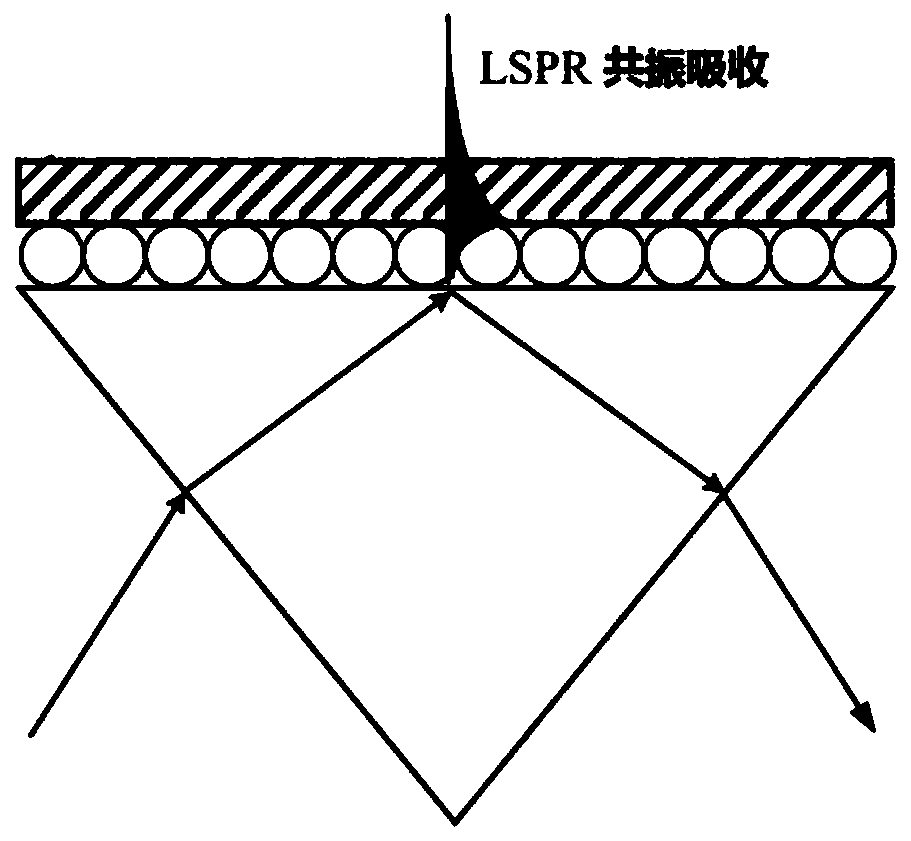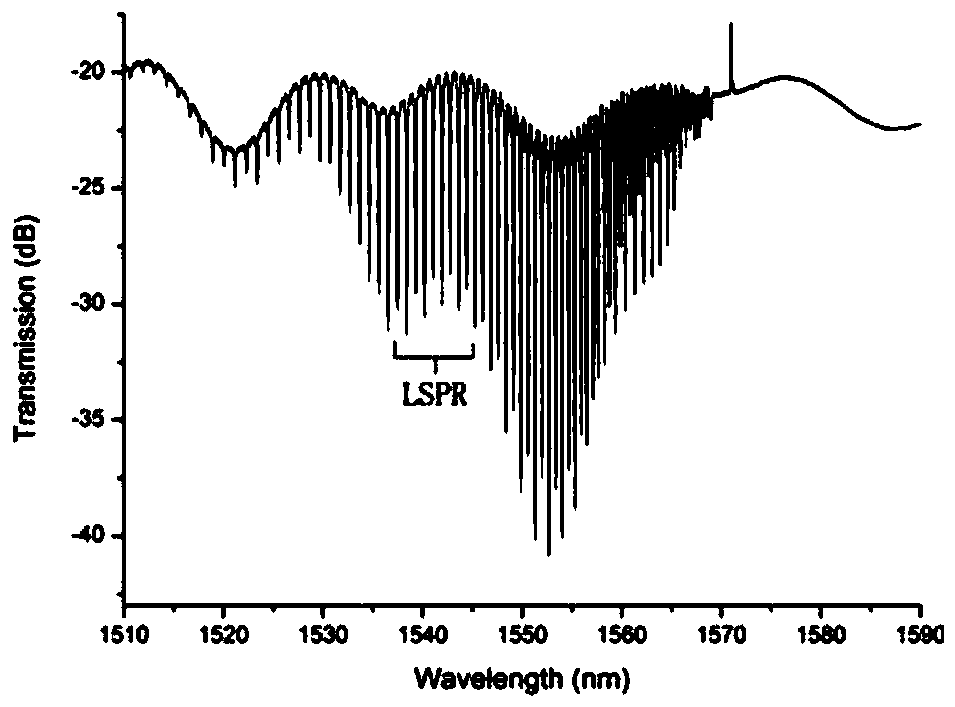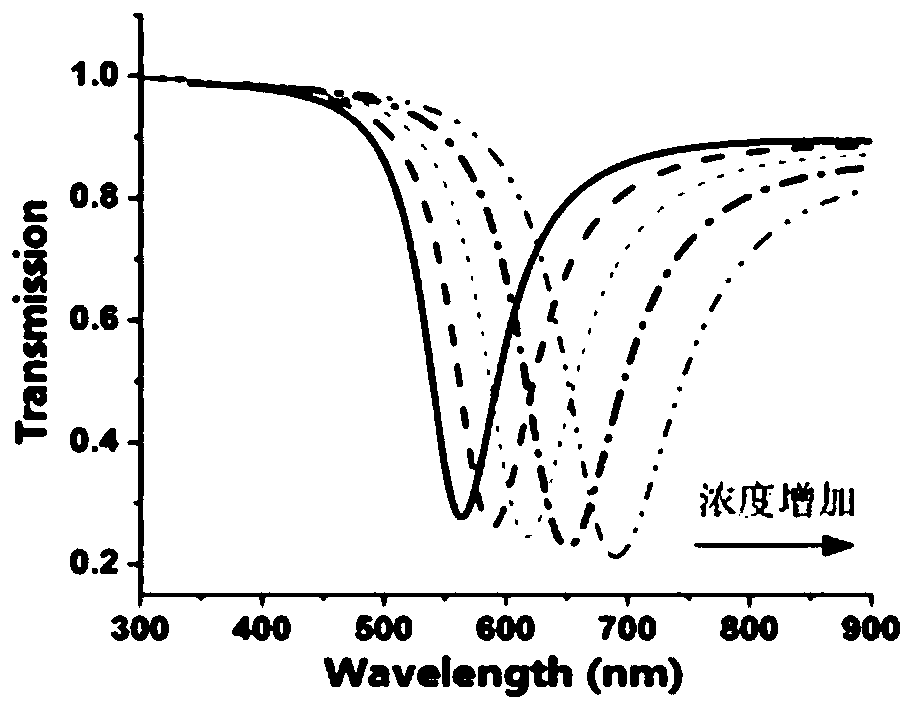Broadband interference type photoelectrode biomolecular sensor of graphene oxide fiber bragg grating
A fiber Bragg grating and biomolecular technology, applied in the direction of material analysis, instruments, and scientific instruments through optical means, can solve the problems of small detection range of biochemical sensors, reduced mechanical strength and robustness of sensors, and large volume of LSPR sensors
Inactive Publication Date: 2020-02-21
CHONGQING UNIV OF TECH +1
View PDF9 Cites 9 Cited by
- Summary
- Abstract
- Description
- Claims
- Application Information
AI Technical Summary
Problems solved by technology
At present, most commercialized LSPR sensors are based on the Kretschmann prism coupling structure for angle detection, such as figure 1 As shown, but this type of LSPR sensor is large in size, long in scan time, and expensive
Because optical fibers have the advantages of corrosion resistance, anti-electromagnetic interference, small size, and remote sensing, various optical fiber materials and devices can be used as excitation platforms to realize the miniaturization of LSPR sensors, such as: based on multimode quartz (or polymer materials ) optical fiber, different-core structured optical fiber or photonic crystal optical fiber, etc., these all belong to the type of pure optical fiber LSPR sensor, but most of them have a main problem: the resonance bandwidth of the LSPR peak is generally in the tens of nanometers to one hundred between many nanometers, so the quality factor (i.e., Q-value) of the sensor is low
[0006] However, the common problems existing in the above-mentioned existing optical fiber LSPR technologies are: 1) most of them adopt the method of detecting transmission spectrum, and the light source and spectrum analyzer are respectively located at both ends of the sensor, which is not convenient for actual integration and use; 2) nanometer The binding ability of gold particles to biomolecules is relatively weak (about 1pg / mm 2 ), resulting in a small detection range of biochemical sensors; 3) traditional optical fiber SPR / LSPR sensors are based on the principle of SPR / LSPR resonance wavelength shift or resonance absorption power change to detect the amount of target biomolecules, while for optical fiber surface It is difficult to monitor the dynamic process of the reaction (combination) between the sensitive layer of biomolecules and biomolecules in real time
This is because the biomolecular reaction (combination) process is a slow variable, and the resonance wavelength shift or the change of the resonance absorption power caused by a short period of time is very weak, and the resolution of the current spectrometer (1pm) cannot Signal noise such as such a subtle change in the resonance wavelength of the distribution, or a weak fluctuation in the intensity of the light source, will overwhelm the change in the resonance absorption power of the LSPR
Other individual problems are: 1) The LSPR spectra excited by pure fiber-based LSPR sensors are all in a certain wavelength range between 500nm and 900nm, and the bandwidth is generally >50nm, such as image 3 Shown is a schematic diagram of pure fiber-optic LSPR sensors increasing with the concentration of substances to be measured, so the Q value of the sensor is very low, and most of them need to corrode or grind the fiber cladding to excite LSPR, thus reducing the mechanical strength and Robustness; 2) The cladding modes of the small-angle TFBG-LSPR sensor in the communication band (1500nm~1600nm) resonance spectrum envelope are too dense and numerous, and it is inconvenient to accurately locate the LSPR peak in practical applications
Method used
the structure of the environmentally friendly knitted fabric provided by the present invention; figure 2 Flow chart of the yarn wrapping machine for environmentally friendly knitted fabrics and storage devices; image 3 Is the parameter map of the yarn covering machine
View moreImage
Smart Image Click on the blue labels to locate them in the text.
Smart ImageViewing Examples
Examples
Experimental program
Comparison scheme
Effect test
Embodiment Construction
[0029] Further detailed explanation through specific implementation mode below:
the structure of the environmentally friendly knitted fabric provided by the present invention; figure 2 Flow chart of the yarn wrapping machine for environmentally friendly knitted fabrics and storage devices; image 3 Is the parameter map of the yarn covering machine
Login to View More PUM
| Property | Measurement | Unit |
|---|---|---|
| angle | aaaaa | aaaaa |
| grating period | aaaaa | aaaaa |
| size | aaaaa | aaaaa |
Login to View More
Abstract
The invention relates to a photoelectrode biomolecular sensor, in particular to a broadband interference type photoelectrode biomolecular sensor and method of a graphene oxide fiber bragg grating. Thesensor comprises an optical fiber core, an optical fiber cladding, an optical fiber coating layer, and a large-angle inclined fiber bragg grating arranged in the middle of the optical fiber core; coating layers of the middle section and the rear section of an optical fiber are completely removed, the tail end surface of the rear section of the optical fiber is plated with a silver reflecting film, the distance between the rear end of the large-angle inclined optical fiber grating and the silver reflecting film at the tail end of the optical fiber ranges from 30 mm to 60 mm, and an optical fiber micro Michelson interference cavity is formed. A silane layer, a nano gold shell particle layer, a graphene oxide layer and a biomolecule sensitive layer are arranged on the cladding surface from the starting end of the large-angle tilted fiber bragg grating to the tail end of the optical fiber. The photoelectrode biomolecular sensor structure can be used to increase the action distance betweenLSPR excited by a light wave evanescent place and biomolecules, is convenient to integrate and apply, has very high robustness, and can be applied to the fields of biomedicine, life science, environmental monitoring and the like.
Description
technical field [0001] The invention relates to an optode biomolecular sensor, in particular to a graphene oxide optical fiber grating broadband interference optode biomolecular sensor and a method. Background technique [0002] Graphene has excellent characteristics such as large specific surface area, high electron mobility, high conductivity, and biomolecular affinity. Its oxide, graphene oxide, also contains abundant oxygen-containing functional groups such as carboxyl and hydroxyl groups. It is beneficial for covalent or non-covalent linking with biomolecules, etc. Therefore, the biochemical sensing technology that combines two-dimensional materials such as graphene and graphene oxide with traditional electrochemical, piezoelectric, and optical sensors, such as surface plasmon resonance sensors and various types of optical fiber sensors, has been obtained. Extensive research. [0003] In the field of biochemical detection, the Surface Plasmon Resonance (SPR) sensor is...
Claims
the structure of the environmentally friendly knitted fabric provided by the present invention; figure 2 Flow chart of the yarn wrapping machine for environmentally friendly knitted fabrics and storage devices; image 3 Is the parameter map of the yarn covering machine
Login to View More Application Information
Patent Timeline
 Login to View More
Login to View More Patent Type & Authority Applications(China)
IPC IPC(8): G01N21/59G01N21/23
CPCG01N21/59G01N21/23G01N2021/5903
Inventor 罗彬彬
Owner CHONGQING UNIV OF TECH
Features
- R&D
- Intellectual Property
- Life Sciences
- Materials
- Tech Scout
Why Patsnap Eureka
- Unparalleled Data Quality
- Higher Quality Content
- 60% Fewer Hallucinations
Social media
Patsnap Eureka Blog
Learn More Browse by: Latest US Patents, China's latest patents, Technical Efficacy Thesaurus, Application Domain, Technology Topic, Popular Technical Reports.
© 2025 PatSnap. All rights reserved.Legal|Privacy policy|Modern Slavery Act Transparency Statement|Sitemap|About US| Contact US: help@patsnap.com



